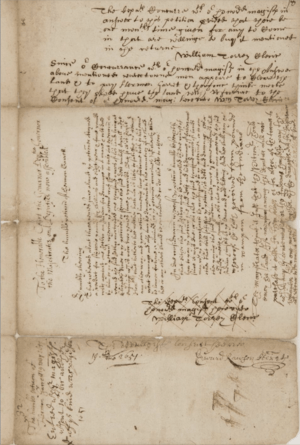Tantamous facts for kids
Tantamous (also known as Old Jethro or John Jethro) was an important Native American leader. He was part of the Nipmuc people in Massachusetts during the 1600s. Tantamous was a powwow, which means he was a healer and spiritual guide for his community. He lived near the Assabet River and later in a place called Nobscot, which is now Framingham. Some say he got his English name, Jethro, because he gave good advice.
Contents
Early Life of Tantamous
Tantamous likely lived near the Assabet River, in what is now Maynard, when he was younger. Around 1635, he or his son, Peter Jethro, was present when Native Americans sold land to colonists in what is now Concord. In 1651, Tantamous transferred land in Maynard to a man named Herman Garrett. This happened because Tantamous could not pay back a loan involving a horse and a colt.
Later in his life, Tantamous lived with twelve family members. They lived on the northwest side of Nobscot Hill, a place now found in Framingham and Sudbury.
King Philip's War and Tantamous's Death
Tantamous did not join the "praying Indians" who followed the Christian religion of John Eliot. In 1675, Tantamous and ten other Native Americans were wrongly accused of a crime during the Lancaster raid. They were suspected because they were singing and had gunpowder. However, they were found innocent when the real person responsible, Monoco, was discovered. Tantamous's son, Peter Jethro, even helped communicate with the people who had captured Mary Rowlandson to help her get free.
During King Philip's War, the government ordered Tantamous and his family to Deer Island. Tantamous managed to escape from Deer Island. However, his son, Peter, told the authorities where his father was. Peter was told his family would not be harmed.
On September 9, 1676, Tantamous tried to arrange a meeting with colonial leaders. He wanted to bring Canonicus, a Narragansett leader, to the government. But Tantamous was captured and sadly died on September 26, 1676. He was marched through the streets of Boston with a rope around his neck before his death. Some historians believe Peter Jethro might have been trying to help his father. They think Peter might have wanted to turn in only Monoco, the person responsible for the Lancaster raid. It is possible that Tantamous and Monoco planned to surrender peacefully. Sadly, most of Tantamous's family, except Peter, were forced into slavery.
Years later, in 1683, several Native Americans signed a letter to John Eliot. They asked for church services to continue in the Nipmuc language. One of the signers was "Olt Jetro." This might have been Peter Jethro using his father's name, or another Native American leader might have adopted the name.
Tantamous's Legacy
Even centuries after his death, you could still see parts of Tantamous's home, orchard, and farm fields. These were located in Framingham and Sudbury on Nobscot Hill. You can still see parts of his collapsed cave near a spot called Jethro's Table, also known as Tantamount Lookout.
Tantamous's name is remembered in several places today. There is Tantamouse Trail in Sudbury and Jethro Street in Maynard. The Tantamous Lodge of the Boy Scouts is also named after him. Part of Tantamous's land on Nobscot Hill is now part of the Nobscot Boy Scout Reservation. Here, you can find a Jethro Trail and Tantamous Hill.
Images for kids







